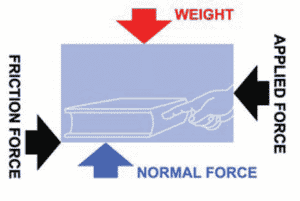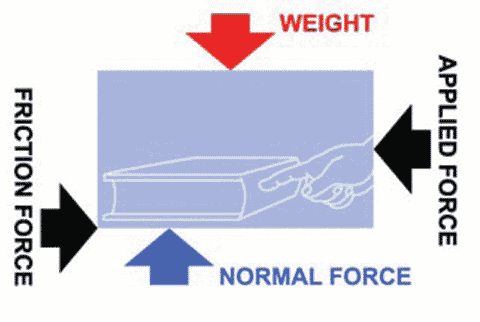Overview
Materials
Per Small Group:
- 3 marbles
- A smooth surface
- Piece of very rough sandpaper (6″ x 6″ or larger)
- 3 coins
- Various surfaces, such as:
- A wooden surface (cutting board or desk top)
- A carpeted surface or a piece of carpeting
- A cookie sheet, coated with ice
- Piece of plywood or very sturdy cardboard
Instructions
Students experiment with marbles and coins on various surfaces as a way to learn about the science of objects in motion, including the concepts of statics, dynamics, and friction.
PREPARATION:
Before class, pour water on the cookie sheet and freeze it. Prepare other surfaces as necessary.
IN CLASS:

- Explain that friction on a surface can make objects hard to push. The coefficient of friction is a measurement used to calculate the effect a surface has on motion.
- Ask the class to make predictions about how the marbles and coins will move on the different surfaces.
- Drop a few marbles a short distance above the smooth surface. Ask: What did you observe? Is there much friction between the marbles and the smooth surface?
- Next, drop the marbles onto the sandpaper from the same height. Discuss the results.

- Use a book resting on a desk to explain to students all of the forces acting on a resting object. (See the diagram on the right for guidance.) The direction of each force is important. For example, if you push straight down on a book on a table, no matter how hard you push, the book will not move to the side. The force downward is balanced by an equal and opposite force up from the table. (The book is in static equilibrium.) But if you push hard on the side of the book, the book will move–it is no longer in equilibrium. Friction works against the applied force. But if the applied force is larger than the friction force, the object will move across the table.
- Using a flicking motion, slide the coins across each surface, using the same amount of force each time.

- Show students the various surfaces. Instruct each group to experiment with coins and marbles on each one. Tell them to note their observations on the following questions:
- Which surfaces have the smallest coefficient of friction?
- Which ones have the largest?
- After the students have finished with their experiments, ask them to summarize their findings.
Guiding questions
-
What do you think will happen when the marbles are dropped on a smooth surface?
-
What will happen when the marbles are dropped on the piece of rough sandpaper?
-
Which of the surfaces will have the most friction? The least?
-
With the coin experiment, what happens if you use more force to slide the coin across the surfaces?
Engineering & science connections
- Statics is the science of equilibrium forces, where there is no motion and all the forces are balanced. Dynamics is the science of objects in motion.
- The coefficient of friction is a measurement used to calculate the effect a surface has on motion. A very smooth surface like ice has a very small coefficient of friction, so the force of friction is also very small. With a rougher surface, the coefficient of friction is greater and therefore so is the force of friction. The coefficient of friction is determined for each surface using standardized lab tests, and can be found in engineering reference books for a wide range of surfaces.
- Friction is a force that acts in the opposite direction to the movement of an object. Engineers must consider friction forces when designing things. For example, the friction of a tennis shoe on a clay court is very different from its friction on asphalt or on an indoor court.
- Police can determine how fast a vehicle was moving by measuring how far it skidded once the vehicle’s brakes were locked. This is calculated using the coefficient of friction between the road and the tires. This application can also be used to try to make roads safer by designing them to have more friction in slippery weather conditions.
This activity provided by the Society of Women Engineers.


0 Comments